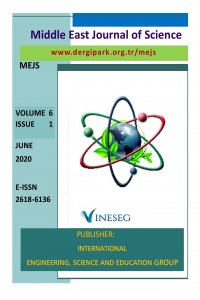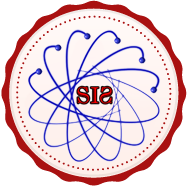Research Article
Year 2020,
Volume: 6 Issue: 1, 32 - 36, 29.06.2020
Abstract
References
- [1] Hudzik, H., “The problems of separability, duality, reflexivity and of comparison for generalized Orlicz–Sobolev spaces ”, Commentationes Mathematicae, 21, 315–324, 1979.
- [2] Musielak, J., Orlicz spaces and modular spaces, Springer, Berlin Heidelberg New York, 1983.
- [3] Orlicz, W., “Über konjugierte Exponentenfolgen”, Studia Mathematica, 3, 200–212, 1931.
- [4] Růžička, M., Elektrorheological fluids: modeling and mathematical theory, Springer-Verlag, Berlin, 2000.
- [5] Acerbi, E., Mingione, G., “Regularity results for stationary electro-rheological fluids”, Archive for Rational Mechanics and Analysis, 164(3), 213-259, 2002.
- [6] Aboulaich, R., et al., “New diffusion models in image processing”, Computers & Mathematics with Applications, 56, 4, 874-882, 2008.
- [7] Chen, Y., et al., “Variable exponent, linear growth functionals in image restoration” SIAM journal on Applied Mathematics, 66, 4, 1383-1406, 2006.
- [8] Zhikov , V.V., “Meyer-type estimates for solving the nonlinear Stokes system”, Differential Equations, 33, 1, 108–115, 1997.
- [9] Amaziane, B., et al., “Nonlinear flow through double porosity media in variable exponent Sobolev spaces”, Nonlinear Analysis: Real World Applications, 10, 4, 2521-2530, 2009.
- [10] Kováčik, O., Rákosník, J., “On spaces and ”, Czechoslovak Mathematical Journal, 41, 4, 592-618, 1991.
- [11] Diening, L., et al., M., Lebesgue and Sobolev spaces with variable exponents, Springer, 2011.
- [12] Cruz-Uribe, D.V., Fiorenza, A., Variable Lebesgue spaces: foundations and harmonic analysis, Springer Science & Business Media, 2013.
- [13] Harjulehto, P., Hasto, P., “Lebesgue points in variable exponent spaces”, Annales Academiæ Scientiarium Fennicæ. Mathematica, 29, 295–306, 2004.
Year 2020,
Volume: 6 Issue: 1, 32 - 36, 29.06.2020
Abstract
In this study, at first we provide
a general overview of L^p(x)(Ω) spaces, also known as variable exponent
Lebesgue spaces. They are a generalization of classical Lebesgue spaces L^p in the sense that
constant exponent replaced by a measurable function. Then, based on classical Lebesgue space approach
we prove a reverse of Hölder inequality in L^p(x)(Ω). Therefore, our proof in variable
exponent Lebesgue space is very similar to that in classical Lebesgue space.
References
- [1] Hudzik, H., “The problems of separability, duality, reflexivity and of comparison for generalized Orlicz–Sobolev spaces ”, Commentationes Mathematicae, 21, 315–324, 1979.
- [2] Musielak, J., Orlicz spaces and modular spaces, Springer, Berlin Heidelberg New York, 1983.
- [3] Orlicz, W., “Über konjugierte Exponentenfolgen”, Studia Mathematica, 3, 200–212, 1931.
- [4] Růžička, M., Elektrorheological fluids: modeling and mathematical theory, Springer-Verlag, Berlin, 2000.
- [5] Acerbi, E., Mingione, G., “Regularity results for stationary electro-rheological fluids”, Archive for Rational Mechanics and Analysis, 164(3), 213-259, 2002.
- [6] Aboulaich, R., et al., “New diffusion models in image processing”, Computers & Mathematics with Applications, 56, 4, 874-882, 2008.
- [7] Chen, Y., et al., “Variable exponent, linear growth functionals in image restoration” SIAM journal on Applied Mathematics, 66, 4, 1383-1406, 2006.
- [8] Zhikov , V.V., “Meyer-type estimates for solving the nonlinear Stokes system”, Differential Equations, 33, 1, 108–115, 1997.
- [9] Amaziane, B., et al., “Nonlinear flow through double porosity media in variable exponent Sobolev spaces”, Nonlinear Analysis: Real World Applications, 10, 4, 2521-2530, 2009.
- [10] Kováčik, O., Rákosník, J., “On spaces and ”, Czechoslovak Mathematical Journal, 41, 4, 592-618, 1991.
- [11] Diening, L., et al., M., Lebesgue and Sobolev spaces with variable exponents, Springer, 2011.
- [12] Cruz-Uribe, D.V., Fiorenza, A., Variable Lebesgue spaces: foundations and harmonic analysis, Springer Science & Business Media, 2013.
- [13] Harjulehto, P., Hasto, P., “Lebesgue points in variable exponent spaces”, Annales Academiæ Scientiarium Fennicæ. Mathematica, 29, 295–306, 2004.
There are 13 citations in total.
Details
| Primary Language | English |
|---|---|
| Subjects | Mathematical Sciences |
| Journal Section | Article |
| Authors | |
| Publication Date | June 29, 2020 |
| Submission Date | November 18, 2019 |
| Acceptance Date | June 18, 2020 |
| Published in Issue | Year 2020 Volume: 6 Issue: 1 |

This work is licensed under a Creative Commons Attribution-NonCommercial-NoDerivatives 4.0 International License.











